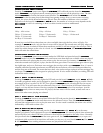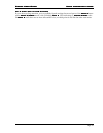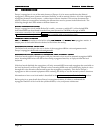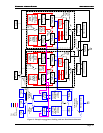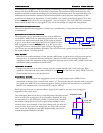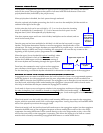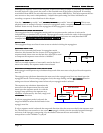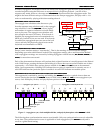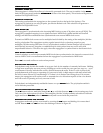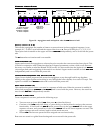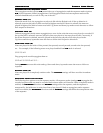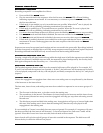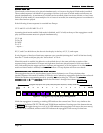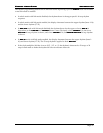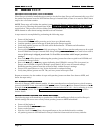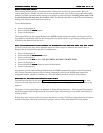
Arpeggiator
ArpeggiatorArpeggiator
Arpeggiator
Europa User Guide
Europa User GuideEuropa User Guide
Europa User Guide
Page 36
Internal clock (A)
Internal clock (A)Internal clock (A)
Internal clock (A)
The arpeggiator is clocked from Europa’s internally generated clock. The rate is settable via the RATE
RATERATE
RATE
knob on the front panel (under the ARPEGGIO
ARPEGGIOARPEGGIO
ARPEGGIO section of the front panel). This selection will generate a
standard 24 PPQN MIDI clock.
External clock (B)
External clock (B)External clock (B)
External clock (B)
This setting synchronizes the arpeggiator to the external clock on the back of the Jupiter 6. The
arpeggiator is clocked at one step per pulse, just like the Roland code. This selection will generate a
standard 24 PPQN MIDI clock.
MIDI Clock (C)
MIDI Clock (C)MIDI Clock (C)
MIDI Clock (C)
The arpeggiator is synchronized to the incoming MIDI clock at a rate of 24 pulses per step (PPQN). The
arpeggiator’s standard stepping is on a eighth note basis. MIDI Clock (unlike internal and external
settings) will NOT be transmitted when synchronized to an external MIDI clock source.
External and MIDI clock sources can be multiplied and divided by the setting of the multiplier/divider
and by polyrhythm. The arpeggiator needs a regular interval clock to function properly at any
multiplier/divider setting other than 1X or if polyrhythm is enabled. Gradual changes will be tracked
and followed, but uneven, irregular, or sudden drops in clock pulses from any source will yield
unpredictable behavior. This does not apply when the arpeggiator is synchronized to the internal clock.
MIDI Clock transmit (
MIDI Clock transmit (MIDI Clock transmit (
MIDI Clock transmit (D)
D)D)
D)
Controls whether or not Europa transmits MIDI clock when synchronized to the internal or external clock
sources. MIDI Clock is not transmitted when the arpeggiator is synchronized to MIDI clock.
Button E
EE
E is not used and has no action when pressed.
Pol
PolPol
Polyrhythm setting (F)
yrhythm setting (F)yrhythm setting (F)
yrhythm setting (F)
Polyrhythm evenly divides the number of steps per clock by the number of currently held notes. Holding
a single note would play one note per step, holding two notes would play two notes per step, etc… up to
a maximum of 16 notes with the time evenly divided between the notes. If the 17
th
note is played, the
polyrhythm mode will revert to operating as if one note is held. At high tempos with many notes held,
the effect is more like an LFO modulating a VCO than it is of distinct notes being played. At extreme
tempos, the arpeggiator will not have time to transmit the voice allocation requests to the voice boards
and will revert to operating as if only one note is held.
Polyrhythm is an independently enableable feature on a per-SPLIT
SPLITSPLIT
SPLIT basis. The polyrhythm enable is
saved with the preset edit.
Multiplier/divider
Multiplier/dividerMultiplier/divider
Multiplier/divider settings (1
settings (1 settings (1
settings (1 -
--
- 8)
8) 8)
8)
The 1
11
1-
--
-8
88
8 buttons select a multiplier (buttons 1
11
1-
--
-
4
44
4) or a divider (buttons 5
55
5-
--
-8
88
8) on the incoming step clock.
Only one of the eight options can be set. The multiplier/divider is independently selectable for both the
upper and lower SPLITS
SPLITSSPLITS
SPLITS (when in SPLIT
SPLITSPLIT
SPLIT mode) and is saved with the preset edit.
Arpeggiator mode and options
Arpeggiator mode and options Arpeggiator mode and options
Arpeggiator mode and options
Arpeggiator mode and options are selected by pressing the UP
UPUP
UP button and holding it for more than 1
second. Buttons A
AA
A-
--
-F
FF
F and1
11
1-
--
-8
88
8 then have the meaning as shown in Figure 10.



